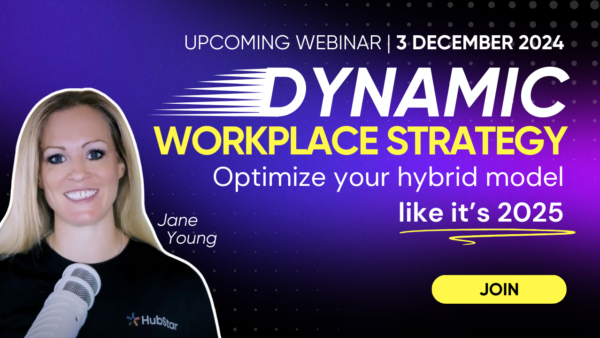What is Hybrid Occupancy Optimization?

From boosting employee well-being to saving millions on real estate costs, the hybrid work model has done us a lot of good. Even so, many workplace leaders are still grappling with how to optimize their hybrid office.
A staggering 65% of businesses admit that their offices aren’t fit for purpose, even as they’re mandating employees back in.
As Gensler’s 2024 Workplace Survey puts it, “Having a space that is simply functional and effective will not create a desirable workplace for employees.”
This is why hybrid occupancy optimization has now become essential.
Upcoming Webinar | Optimize your Hybrid Model Like It's 2025
What does it take to make your hybrid workplace functional, effective AND desirable for 2025? Grab your spot at our upcoming webinar to find out!

In this post, we’ll explore what hybrid occupancy optimization is and why it’s key to making hybrid work successful.
What is hybrid occupancy optimization?
Hybrid occupancy optimization is the process of continuously improving hybrid work spaces, policies and technologies.
In other words, hybrid occupancy optimization is the process of making sure your office is fit for purpose and fit for the people occupying it.
It’s about providing the right spaces to the right people at the right times while finding opportunities for cost and operational savings.
That’s a lot of moving parts to successfully pull off all at once.
Challenges of hybrid occupancy optimization
Every new system creates new challenges, and hybrid work is no different.
A 2023 study found that although hybrid working improved retention and employee financial wellbeing, it damaged organizational purpose, effective leadership and organizational culture.
Trying to improve something as fluid and ever changing as hybrid work comes with its own set of challenges.
Here are a few.
- Team collaboration and ways of working
48% of employees in a survey of almost 3000 have had no formal or informal discussions around the best ways to collaborate in a hybrid environment. Even more concerningly, 24% reported their teams have never met to discuss how to improve hybrid working.
- Fluctuating occupancy patterns
Even with strict return-to-office mandates in place, occupancy in a hybrid office is unpredictable. 20% of employees ignore mandates requiring them to be in the office on specific days of the week. Almost half of managers ignore absences. So even the strictest in-office rules don’t impact employee behaviour, making it almost impossible to plan office portfolios around employee attendance.
- Changing workplace design needs
Hybrid work hasn’t just changed where employees work, but how they work. This is a good thing, because employees are coming into the office with a specific purpose, like collaboration, mentorship meetings or company events. These evolving needs have forced office layouts and technology into a full 180. Instead of cubicle farms illuminated by the harshest fluorescent lighting, we’re seeing destination offices with umpteen collaboration spaces, plants and great coffee.
If workplace design hinders progress if it doesn’t adapt, decreasing productivity, and increasing talent loss. Fortune 500 companies already lose over 25 billion hours annually due to ineffective collaboration. Workplace design can provide the right environments for effective collaboration and increase the likelihood of it occurring.
- Office portfolio size
$1.5 in in commercial real estate debt in the US is set to mature by the end of 2025. With many organizations stuck in long leases without the ability to sublet, uncertainty around exactly how much office space is needed is a recipe for disaster.
Benefits of hybrid occupancy optimization
It goes without saying that creating a process for improving something is always a good thing – especially when that process impacts how people spend a third of their lives.
This has some pretty far-reaching benefits that improve both employee experience and business performance. And that’s a win-win in our books.
Here are a few of those benefits.
- Better productivity
An optimized hybrid office gives people the right environment to totally nail what’s on their to-do list, whether that’s collaboration or head-down work. Employees come into an optimized hybrid office with a purpose, and purpose equals productivity.
- A better employee experience
Beer fridges, ping pong tables and free lunches have been done to death. But a workplace that continuously adapts its policies, spaces and functionalities to support you doing your best work? That’s the epitome of a great employee experience – one that makes people want to come back into the office again and stay with your organization.
- A more cohesive organizational culture
When the office is fit for purpose and the right hybrid guidelines and policies are in place, people feel supported and empowered. That means increased psychological safety and a sense of belonging, creating an environment where innovation and stronger relationships happen naturally.
- Cost efficiency
Consistently empty office space is the bane of any CRE team’s existence. It costs a lot to keep operating those empty spaces, even more so when no one’s getting any value out of them. Hybrid occupancy optimization cuts costs – firstly by making spaces fit for purpose, so employees get more out of them, and secondly by uncovering underutilized spaces the organization can let go of.
- Reduced carbon emissions
Less space sitting empty equals less carbon emitted. What’s more, optimized occupancy levels cut under and overcrowding, which also reduces use of energy and maintenance needs. With Net Zero by 2030 looming on the horizon for most companies, monetary costs aren’t the only ones that need to be reduced.
4 Ways to Reduce Office Carbon Footprint by Understanding Workplace Occupancy
Measuring workplace occupancy uncovers sneaky opportunities to reduce carbon emissions. Here's how.

Three steps to optimizing hybrid occupancy
1) Figure out what it takes to attract people into the office.
We’ve already been over the data – mandates often get ignored and don’t always boost attendance. So to get more people in the office, they need to be there by choice.
People will choose the office when it’s fit for purpose. So the first step to attracting employees into the office is to figure out what employees want and what’s important to them.
If it’s building social capital, find ways to proactively inform employees when their friends and colleagues will be in. Scheduling tools are a big help here, as long as they’re not too difficult to use. Promoting key events like huddles, socials, and team days creates a sense of community.
There’s compelling evidence for granting teams the autonomy to decide their schedules, ensuring they feel empowered. A recent study by Slack found that employees who feel trusted are twice as productive as those who don’t.
This holistic approach just scratches the surface. But the name of the game is to foster a vibrant and voluntary office culture, making the office a destination of choice.
3 Things Destroying Social Connection in Your Hybrid Workplace
If you’re looking to build social connection in your office and have one or all of these 3 things going on, you’re doing more harm than good.

2) Analyze workplace patterns and preferences
Understanding how employees use the workplace is the first step to better office design. Measuring usage on a granular level – tracking the use of floors, neighborhoods, and conference rooms over time – gives you quantitative detail of what’s working well now and what isn’t. This detailed analysis goes beyond basic badge swipe data, which doesn’t provide enough detail.
By analyzing past and present utilization patterns, workplace leaders can predict the types and amounts of spaces employees will need in the future. This data-driven approach optimizes the workplace to meet employee needs, as they evolve. Which they will.
What’s more, analysis highlights the unpopular areas sitting empty too frequently. These are the spaces haemorrhaging costs and carbon emissions.
5 Space Utilization Metrics for a Better Workplace in 2024
Looking for the right workplace metrics? These five are your springboard into better workplace design and experience.

3) Adapt your hybrid occupancy strategy on the fly
The ideal configurations of hybrid policies, workplace design, technologies and portfolio sizes are constantly changing. That’s what makes hybrid workplaces such a challenge to manage. The pressure is on to evolve at a million miles an hour, all without disrupting business operations or employee experience.
On-the-fly hybrid strategy adaptation requires three things:
- Extensive departmental cross-collaboration
- An experimental approach
- The right tech stack
It’s never been more urgent for HR, space planners, architects, real estate and operations teams to work cross-functionally, even if they haven’t always done so in the past.
An experimental approach uses data to test the effectiveness of new ideas on a smaller scale before rolling them out across the entire organization, avoiding costly and often irreversible mistakes.
The right tech stack provides the data to facilitate fact-based conversations between departments, predict which changes will work and measure performance. What’s more, it should provide a means for making the speed and frequency of changes (e.g. editing floor plans) feasible.
Upcoming Webinar | Optimize Your Hybrid Model Like It's 2025
Trying to get your hybrid shizzle together in time for 2025? Grab your place at our upcoming webinar to for a dynamic new framework.

Share this post
Similar posts

















